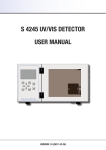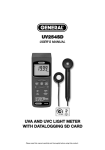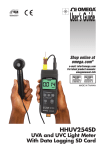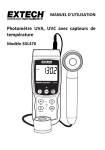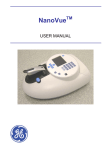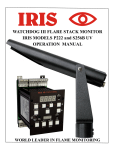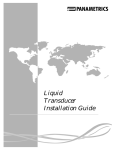Download USER MANUAL S 4345/4350 PDA DETECTOR
Transcript
S 4345/4350 PDA DETECTOR USER MANUAL VERSION 1.0 (2013-01-08) 2 TABLE OF CONTENTS 1.Introduction 1.1 How to Use this Manual 1.1.1 Symbols 1.2 Safety Information 1.2.1 1.2.2 1.2.3 1.2.4 General Safety Information Intended Purpose Environmental Safety Electrical Safety 2. Instrument Overview 2.1 General Instrument Overview 3. Instrument Description 3.1 General Instrument Description 3.1.1 Front Panel Description 3.1.2 Back Panel Description 3.2 Functional Description 3.2.1 Front Elements 3.2.2 Functional Elements (256 Diodes) 3.2.2 Functional Elements (1024 Diodes) 4. Instrument Setup 4.1Unpacking 4.2 Capillary Connections 4.3 Backside Connections 4.3.1 Electrical Connections 5. Instrument Menus 5.1Keyboard 5 5 5 6 6 6 6 7 9 9 11 11 11 13 14 14 15 16 17 17 17 18 18 19 5.2 Status Screen 5.3 Menu Description 20 21 6. Instrument Operation 25 5.3.1 Submenu: PDA Lamp Info 5.3.2 Submenu: System 6.1Overview 6.1.1 LAN Mode 6.1.2 DHCP Mode 6.1.3 RS232 Mode 7. Instrument Maintenance 7.1Flowcell 7.1.1 Flowcell Assembly 22 23 25 25 25 25 27 27 27 7.2 Deuterium & Tungsten Lamps 28 Appendix A: Specifications 29 7.2.1 Lamp Exchange A.1 Technical Specifications A.2 Environmental Conditions A.2.1 Operational Conditions A.2.2 Storage Conditions 28 29 30 30 30 Appendix B: Accessories 31 Appendix C: Version Control 33 B.1 Standard Accessories C.1 Version History 31 33 19 3 4 1.INTRODUCTION 1.1 How to Use this Manual This manual is designed as a reference to the installation, operation and maintenance of the S 4345/4350 PDA Detector. It is strongly recommended to review this manual before operating the instrument. The content of this manual is subject to change without notice. This document is believed to be complete and accurate at the time of publication. The Manufacturer is not liable for any damage resulted from the use of this manual. 1.1.1 Symbols Throughout this manual important text sections are marked with the following symbols: This section includes important information which may result in instrument or personal damage if not carefully followed. This section includes important information for the proper operation of the instrument. Failure to follow this information may result in faulty behaviour of the instrument and/or wrong analysis results. This section emphasis some detailed information intended to optimize the performance of the instrument or to give a better understanding of some technical details. STOP ! ! WARNING NOTE 5 1.2 Safety Information This instrument is compliant with all related standards as stated in Appendix B. 1.2.1 General Safety Information The operation of any analytical instrumentation requires the operator to be familiar with the potential hazards of using chemical solvents. To avoid personal injury and/or damage to the instrument the operator is responsible to follow all safety information herein. The manufacturer assumes no liability for any damage resulted from not following any of these safety procedures. 1.2.2 Intended Purpose This instrument is designed and certified as a general purpose laboratory instrument for research and routine analysis work only. It is not certified for in-vitro or other medical applications. Any use outside this intended purpose does not fall with the manufacturer’s liability. 1.2.3 Environmental Safety Only operate the instrument in well-ventilated areas. If volatile or flammable solvents are used with this instrument, arrange for proper disposal of any waste and/or fumes. Always properly dispose any waste solvents. Avoid open flames and sparks when working with flammable and volatile solvents. In case of instrument leakage, turn off the instrument and remedy the leakage problem immediately. 6 1.2.4 Electrical Safety Always use the provided power cords. Replace faulty power cords and other cables before operating the instrument. Always replace blown fuses with original spare fuses. When the instrument’s housing is open, electrical connections will be exposed. Disconnect the instrument from the main power before opening the housing. The housing should only be opened by certified service personnel! Damage of the instrument of injury may result from improper handling. STOP ! 7 8 2.INSTRUMENT OVERVIEW 2.1 General Instrument Overview The S 4345/4350 PDA Detector is a photo-diode-array (PDA) detector for routine analysis and sophisticated research. The dual lamp design offers a wavelength range of 190 – 720 nm (256 Diodes) or 190 – 1015 nm (1024 diodes) with a low baseline noise. The front-accessible flowcell can easily be exchanged, as can be the lamps which are accessible through a side panel in the instrument housing. 4-Channel Detector The S 4345/4350 PDA Detector features 4-Wavelength channels to measure chromatograms at 4 different wavelengths at the same time. With this feature the optimum wavelength can be selected for each analyzed substance. Optional – Ananlog Output The S 4345/4350 PDA Detector is available with an optional 4-Channel analog output. This D/A converter output option is offered to keep the system flexible to be used with any data acquisition software available. 9 Figure: S 4345/4350 Optical Module (256-Diodes) 10 3.INSTRUMENT DESCRIPTION 3.1 General Instrument Description 3.1.1 Front Panel Description The front panel of the S 4345/4350 PDA Detector consists of three main elements: the TFT Display (1), the Keyboard (2) and the Front Cover (3). The 3” TFT Display shows the current status information and is used with the Keyboard to adjust instrument settings and fully operate the instrument in stand-alone mode without a PC required. The Front Cover has a view panel, so that the important parts are always visible to the operator. In case of a leak it can be detected before solvents are leaking out of the bottom of the Front Cover. The Front Cover can be opened to easily access the flowcell. # Element 1 TFT Display 2 Keyboard 3 Front Cover 11 Removing the Front Cover The Front Cover of the S 4345/4350 PDA Detector is completely removable at its hinges. • Open The Front Cover to 90° (in order to get free of any instrument stacked on top) • Remove the Front Cover • Store the Front Cover at a safe place 12 3.1.2 Back Panel Description The back panel of the S 4345/4350 PDA Detector houses the power and interface connectors and several drain outlets. The Power Cord Connection & Power Switch housing holds the main fuse in an internal fuse carrier. The digital I/O and other interface connectors are used for remote instrument control and are discussed in a later chapter. # Element 1 Instrument Serial Number 2 Power Cord Connection & Power Switch 3 Remote Digital I/O Connector 4 LAN Interface Connector 5 RS-232 Interface Connectors 6 RS-485 Interface Connector 13 3.2 Functional Description 3.2.1 Front Elements The S 4345/4350 PDA Detector has all important parts directly accessible from the front panel when the Front Cover is opened or removed. The Capillary Holder (3) holds the pump inlet capillary in place. The flowcell (4) is completely accessible from the front to make capillary connections to the flwcell inlet (5) and outlet (6) and can be easily removed with 2 screws.. # Element 1 TFT Display 2 Keyboard 3 Capillary Holder 4 Flowcell 5 Flowcell Inlet 6 Flowcell Outlet 14 3.2.2 Functional Elements (256 Diodes) All functional elements of the S 4345/4350 PDA Detector are located inside the instrument. The Display PCB (1) controls the TFT Display and Keyboard. It is accessible when the display panel is removed. The Lamp Power Supply Unit (2) supplies the required voltage and ignition sequence for the Deuterium lamp. The Power Supply Unit (3) supplies 24V to the PCB’s. The input voltage is variable from 90 V to 240 V (5). The Controlled PCB (4) controls the whole pump. The Fan (6) is mounted on the back panel and is important for regulating the internal temperature. The Lamp Connector Rack (7) is used for easy connection of Deuterium and Tungsten lamps from the side panel of the instrument. # Element 1 Display PCB 2 D2-Lamp Power Supply 3 24V Power Supply Unit 4 Controller PCB 5 Mains Connector 6 Fan 7 Lamp Connector Bracket 8 Optical Module 15 3.2.2 Functional Elements (1024 Diodes) All functional elements of the S 4345/4350 PDA Detector are located inside the instrument. The Display PCB (1) controls the TFT Display and Keyboard. It is accessible when the display panel is removed. The Lamp Power Supply Unit (2) supplies the required voltage and ignition sequence for the Deuterium lamp. The Power Supply Unit (3) supplies 24V to the PCB’s. The input voltage is variable from 90 V to 240 V (5). The Controlled PCB (4) controls the whole pump. The Fan (6) is mounted on the back panel and is important for regulating the internal temperature. The Lamp Connector Rack (7) is used for easy connection of Deuterium and Tungsten lamps from the side panel of the instrument. # Element 1 Display PCB 2 D2-Lamp Power Supply 3 24V Power Supply Unit 4 Controller PCB 5 Mains Connector 6 Fan 7 Lamp Connector Bracket 8 Optical Module 16 4.INSTRUMENT SETUP 4.1Unpacking Remove the S 4345/4350 PDA Detector from its package and put it on the working desk. Check the instrument thoroughly for any damage that may have occurred during shipping. Contact your supplier in case of any damages. Check the accessories shipped with the instrument if everything is complete and in good condition. 4.2 Capillary Connections Connect the capillary coming from the separation column to the flowcell inlet (4). Then connect the drain capillary to the flowcell outlet (3). # Element 1 Capillary Holder 2 Flowcell 3 Flowcell Outlet 4 Flowcell Inlet 17 4.3 Backside Connections 4.3.1 Electrical Connections • Connect the supplied power cord to the Mains connector (2). • Connect the supplied RS-232 cable to the RS-232 connector (4) if the instrument is to be operated by PC • Connect the remote control wires to the Digital I/O connector (3) if the instrument is to be run in External mode. Please refer to 5. Instrument Operation for further information about PC control and Remote control. # Element 1 Serial Number 2 Mains connector 3 Remote Digital I/O 4 RS-232 Serial Communication 5 RS-485 Communication Bus 6 USB Communication (not in use) 18 5.INSTRUMENT MENUS 5.1Keyboard The S 4345/4350 PDA Detector parameters can be adjusted at any time via the screen menu and keyboard on the front panel. [MENU] Key With the [MENU] key you can access the Main Menu and select a submenu. [STATUS] Key With the [STATUS] key you can access the status screen from any menu. [EDIT] Key Use the [EDIT] key to change any parameters. When you press the [EDIT] key, the selected parameter can be changed. Confirm the new setting by pressing the [EDIT] key again. [CANCEL] Key With the [CANCEL] key you can abort the change of a parameter. When pressing [CANCEL] key instead of [EDIT] key when changing a parameter, the change is discarded and the original value is used. [CURSOR] Keys The 4 arrow [CURSOR] keys are used to navigate the menus. [ZERO] Key The [ZERO] key sets the baseline absorption value to zero. 19 [PROG] Key The [PROG] key starts the wavelength program (not in use). 5.2 Status Screen The Status Screen shows the most important parameters. Mode The top line shows the currently selected mode: RS232, DHCP, or LAN. Status On the top right the current status is displayed: Run, Error IP Address The currently selected IP Address. 20 5.3 Menu Description With the [MENU] key, the Main Menu is displayed. Use the [CURSOR] key ([UP] and [DOWN]) to browse through the Main Menu for access of one of the Submenus. 21 5.3.1 Submenu: PDA Lamp Info D2 State Select the Deuterium lamp state: ON or OFF. D2 Total Runtime The total runtime of the deuterium lamp in hours.. D2 Total Ignitions The total number of ignitions of the deuterium lamp. Vis State Select the desired Tungsten lamp state: ON or OFF. Vis Total Ignitions The total number of ignitions of the tungsten lamp. 22 5.3.2 Submenu: System COM-Mode Select the communication mode of the detector: LAN, DHCP, or RS232. IP Addr Enter the desired IP Address if running in LAN Mode. SubMask Enter the desired Subnet Mask if running in LAN or DHCP Mode. Display Version The firmware version of the display. Mainboard Version The firmware version of the mainboard. 23 24 6.INSTRUMENT OPERATION 6.1Overview The S 4345/4350 PDA Detector can be operated in 3 different Operation Modes: LAN, DHCP, or RS232 6.1.1 LAN Mode In LAN Mode the instrument is controlled via LAN with a static IP Address. 6.1.2 DHCP Mode In DHCP Mode the instrument is controlled via LAN with dynamic IP Address from the DHCP server. ATTENTION: With high network traffic the data communication might be unstable and can lead to lost data! 6.1.3 RS232 Mode In RS232 Mode the instrument is controlled by a PC software (e.g. Clarity) via RS-232 serial line. The data rate is limited to 5 Hz in this Mode. 25 26 7.INSTRUMENT MAINTENANCE 7.1Flowcell 7.1.1 Flowcell Assembly The following diagram shows all the components of the dismantled flowcell: # Element 1 Holding Screw (SS) 2 Centering Disc (PEEK) 3 Quartz Lens 4 PTFE Sealing 27 7.2 Deuterium & Tungsten Lamps 7.2.1 Lamp Exchange The lamps can be accessed from the left side panel of the instrument. • Remove the side panel to access the lamps # Element 1 Deuterium Lamp 2 Tungsten Lamp 3 Tungsten Lamp Conector 4 Deuterium Lamp Connector Exchange Deuterium Lamp After opening the side panel, the Deuterium Lamp can be accessed. • remove the Deuterium Lamp by loosening the top and bottom screw (1) • disconnect the Deuterium Lamp (4) Now, the Deuterium Lamp can be removed and a new lamp inserted. Exchange Tungsten Lamp After opening the side panel, the Tungsten Lamp can be accessed. • remove the Tungsten Lamp by loosening the PEEK finger-screw on top of the Tungsten Lamp housing (2) • disconnect the Tungsten Lamp (3) Now the Tungsten Lamp can be removed and replaced by a new lamp. 28 APPENDIX A: SPECIFICATIONS A.1 Technical Specifications Wetted Materials: Baseline Noise: Baseline Drift: Number of Diodes: Wavelength Range: Wavelength Accuracy: Mean Pixel Pitch: Linearity Light Source: Wavelength Program: Analog Output Data Rate Dimensions: Weight: Power Supply: Stainless Steel / PEEK*, PTFE, Quartz ± 1 x 10-5 AU (@240nm, 2 sec Risetime) < 3 x 10-4 AU/h 256 or 1024 256-Diodes: 190 - 720 nm 1024-Diodes: 190 - 1015 nm 0.5 nm (256 Diodes); 0.3 nm (1024 Diodes) 2.2 nm (256 Diodes), 0.8 nm (1024 Diodes) > 2.0 AU Deuterium Lamp, Tungsten Lamp Programmable, 10 steps - (optional: 4x 1 V) 1 Hz - 100 Hz 396 x 165 x 478 mm (W x H x D) 7.0 kg 100 – 250 ~V, 47 – 63 Hz * depending on material option 29 A.2 Environmental Conditions A.2.1 Operational Conditions Ambient Temperature: Ambient Relative Humidity: +10 °C to +35 °C 20 to 80 % RH (non-condensing) A.2.2 Storage Conditions Ambient Temperature: Ambient Relative Humidity: 30 -20 °C to +60 °C 20 to 80 % RH (non-condensing) APPENDIX B: ACCESSORIES B.1 Standard Accessories The S 4345/4350 PDA Detector is delivered with the following standard accessories: • 1x Power Cord (EU Type) • 1x Serial Cable (RS-232) • 1xLAN-Cable • 1x 1/16” Drain Capillary, FEP (I.D. 0.8mm, 2 m) • 1x 1/16” Fitting & Ferrule, Stainless Steel • 1x Operation Manual (this) • 2x Fuse, 2 A 31 32 APPENDIX C: VERSION CONTROL C.1 Version History The S 4345/4350 PDA Detector Operation Manual is subject to version control. The version history is continued and noted on every document. The access to the original document is restricted to the creating party. The document is subject to periodical checks and can never reach an unchangeable state. Version Release Date Description 1.0 2015-02-17 First Release 33



































